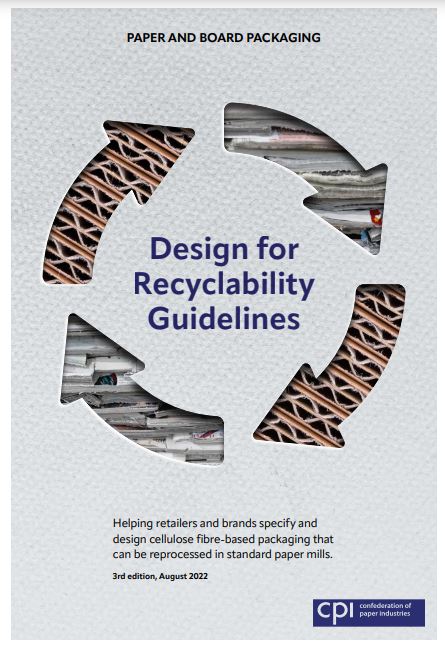OPINION: It was only a few years ago that the BBC Blue Planet series influenced packaging designers to move rapidly away from plastic. As public awareness has grown, the momentum to fibre-based packaging products increases, as designers see the inherent recyclability of paper as one of its key strengths. This is doubled by the public’s perception of the value in fibre-based products. Paper and card packaging products rank the highest with UK consumers for sustainability attributes, including “better for the environment” (69%) and “easier to recycle” (61%)[1].

However, the urgency for fibre-based packaging has led to an enormous variety of formats with very wide applications. These products increasingly enter the raw material supply chain as paper and card products are recycled more than any other material in the UK. In 2021 the UK paper and board recycling rate rose to 71.1%, a 4% increase from the previous year and the highest recycling rate recorded.
Although this is all good news, very complex fibre-based formats may be regarded as sub-optimal for reprocessing by a standard paper mill. As material complexity increases, recycling becomes more complex and more impractical. Technologies that provide paper and board with additional characteristics, such as water or grease resistance or barrier properties can make fibre-based packaging more challenging to recycle. Changes to the composition of raw material stock also leads to additional costs to the Paper Industry due to yield loss and increasing energy, water, chemical and waste management charges.
Anniversary
This year is the 150th anniversary of the founding of the original UK trade association for the paper sector. Effective recycling of fibre-based packaging products has been key to the industry’s long-term credibility and growth. Paper can be recycled with no significant loss in quality and with little to no loss of integrity; it is a renewable material, extremely easy to recycle in its pure form. At the same time, innovative packaging formats that maintain product quality and integrity whilst ensuring longer shelf life and preventing waste, can be of complex composition, but they also need to be easily recoverable and readily recyclable. To find the balance between these two imperatives, the supply chain needs simple and easily understood guidelines that provide design parameters which, if generally adhered to, should deliver recyclable fibre-based packaging.
The CPI Design for Recyclability Guidelines were originally developed in 2019. The document was intended as a first step in helping UK retailers and brands better understand how they might specify and design packaging, so it can be easily reprocessed by paper mills with standard pulping technology. Listening to calls from brands and retailers for greater detail and clarity, almost six months ago, CPI set up a committee to lead the review of the Guidelines. The revised version not only sought to offer guidance on efficient paper recycling, but also give a direction of travel for future packaging design within the upcoming regulatory changes.
Designers
The Guidelines state that nearly all fibre-based products are recyclable, and do not suggest that any products with specifications outside those recommended are unrecyclable. However, they ask designers to consider certain aspects when products are being specified. Moreover, the Guidelines express the preferred position of the Paper Industry based on practical experience and they are not an expression of the acceptability of packaging formats for recycling. To provide a definitive answer on the recyclability of a packaging product, CPI has established Papercycle, a wholly owned subsidiary of CPI, which assesses recyclability and delivers verification and certification services for fibre-based packaging. Papercycle is the tool that determines whether fibre-based packaging formats are recyclable in the UK, and which types of mills can reprocess the packaging. Between the guidelines for recyclable packaging and the certification of the recyclability of the product, Papercycle also offers recyclability assessments for product development for any suppliers and designers who want to test a product before its launch.
The Guidelines have already influenced design behaviours in the UK and stimulated further innovation and technological developments in packaging materials. New formats have appeared on the market, for example fibre-based products with water resistance characteristics and barrier properties which can be recycled in standard paper mills. CPI will maintain a standing committee to undertake periodic review of these Guidelines as new technologies emerge. At the same time, as pan-European efforts to provide guidelines for paper and board packaging[2] intensify, the CPI Guidelines will be as closely aligned as possible with the work being undertaken in the EU.

Delay
All of us working in the sector know the uncertainty the delay in the announcement of the waste reforms has caused, which has been exacerbated by the challenging economic environment. There is still much work to be done for the UK’s EPR system to be fully developed, including on the cost to consumers, and there are remaining questions on how Government is going to define recyclability. There are also more and more calls from the industry on the need to secure high quality recyclate through consistent recycling collection systems. Although there are still questions to be answered and action to be taken, in the short term the revised Guidelines provide a clear support mechanism for designers of fibre-based packaging; they are a move towards the right direction that motivates sustainable design, improves the recyclability of the more challenging materials, and effectively increases the quality of recycling entering the waste stream.











Subscribe for free